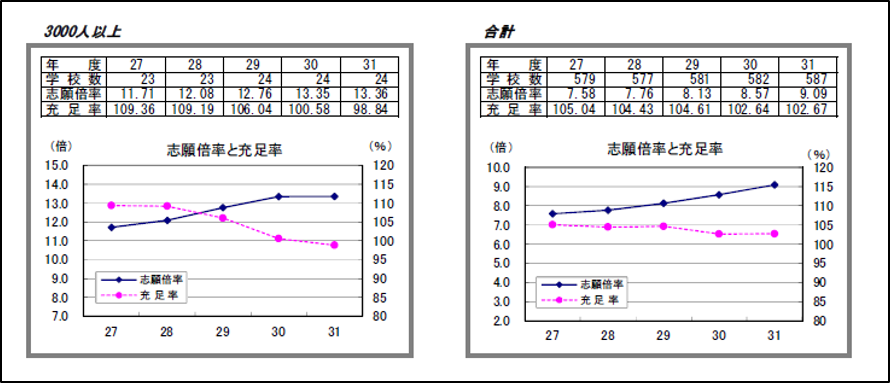The number of applicants for private universities has decreased, and the number of successful applicants?
The number of applicants for this year's private university entrance exams is likely to decrease by about 10%, mainly at difficult universities, due to the steady trend of examinees.In particular, in recent years, the number of applicants has been halved depending on the entrance examination method at universities where the magnification and difficulty of entrance examinations have increased as a joint application school for difficult universities.Will the number of successful applicants decrease in this trend of decreasing applicants?
In general, as the number of applicants increases, so does the number of successful applicants.This is because the number of applicants with other universities is expected to increase, so it is expected that many examinees will pass the university and do not take the admission procedure even if they pass.On the contrary, if the number of applicants decreases, it is considered that the number of applicants with other universities has decreased, so the number of successful applicants is expected to increase in anticipation of an increase in the admission procedure rate.However, there are some cases where this pattern does not apply.For example, if the number of enrollees is higher than planned in the admissions within the year such as the recommendation admissions, even if the number of applicants for the general admissions increases, the number of successful applicants cannot be increased considering the enrollment capacity excess rate. ..Unfortunately, the number of people who have already completed the admission procedure for the recommended entrance examinations of each university has not been announced at this time, so unfortunately the situation is unknown to the examinees.In addition to this, if the number of enrollments in the previous year was higher than planned, it will have to be adjusted over several years.This is a case that corresponds to the above-mentioned "Average enrollment capacity excess rate for the past XNUMX years".
Looking at it in this way, we can see that it is very difficult to predict what will happen in the end because the behaviors of individual universities with different circumstances move in a chain.However, considering the total number of successful applicants at private universities, the enrollment overcapacity rate has dropped considerably over the past few years.In particular, the decline in large-scale private universities, which has an influence on overall trends, is remarkable. From the group materials>.Therefore, the number of applicants is decreasing, but it is unlikely that the number of successful applicants will decrease in proportion.Overall, I think the number of successful applicants will be settled at the same level as last year.Therefore, the magnification will decrease.

<Figure "Trends in application for admission to private universities, junior colleges, etc. in 31 (Trends by scale)" From the materials of the Japan Private School Promotion and Mutual Aid Corporation>
Last year's high-magnification university late-stage entrance exams will have a lower magnification
As mentioned above, the total number of successful applicants at private universities is considered to be about the same as last year, but there are recruitment categories that may increase.It is an entrance exam that takes place from late February to March.Although it is referred to as the late entrance examination here, there are a large number of universities that carry out the late entrance examination, including the method using the National Center Test for University Admissions.
For example, Kokugakuin University, Komazawa University, Seikei University, Seikei University, Senshu University, Chuo University, Toyo University, Japan University, Musashi University, Meiji University, Meiji Gakuin University, Aichi University, Chukyo University, Nanzan University, Meijo University, Kyoto Sangyo In addition to major comprehensive universities such as University, Ritsumeikan University, Ritsumeikan University, Kansai University, Kinki University, Kansai Gakuin University, Konan University, Hiroshima Shudo University, Matsuyama University, Seinan Gakuin University, Showa Women's University, Tsuda College, Tokyo Women's University , Japan Women's University, Feliz Jogakuin University, Kaneshiro Gakuin University, Doshisha Women's University, etc.The number of successful applicants for this late entrance examination has increased last year as well, so it is expected that this trend will continue this year as well.At that time, what I would like to pay attention to is the magnification of last year.
In the latter half of the entrance examination, the difficulty level of the entrance examination (so-called deviation value) is often not set, so for the examinee, only the past magnification is available as a guideline for the difficulty level.Therefore, there are many cases where it is affected by the magnification of the previous year.As a result, it is easy for the magnification to increase or decrease depending on the year.There are many cases where it was 20 times last year and double this year.For these reasons, there is a possibility that there will be an unexpectedly easy recruitment category at a university with a high enrollment capacity at a high magnification last year.In the case of a university with a small enrollment capacity, as mentioned above, there are already enough enrollees in the recommendation entrance examination, and it is possible that many successful applicants cannot be obtained.
After mid-February, some students may not be able to get the results they expected from their private university entrance exams.In that case, it may be worth checking to see if there are still universities that can apply.
- 1
- 2
